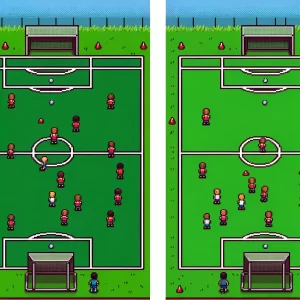
Home vs. Away: What Soccer Coaches Can Learn from Guardiola’s Tactical Evolution
Pep’s not have the greatest year, but we shouldn’t throw away all the tactical prowess he has previously shown. very soccer coach has faced the question: Why does my team perform differently at home than away? Whether it’s the roar of the crowd or the comfort of familiar turf, match location has long been suspected to influence outcomes. But how does this play out tactically?
A recent study analyzing Pep Guardiola’s teams—Barcelona and Manchester City—offers groundbreaking insights into how match location shapes playing styles. For coaches, players, and club leaders, understanding these nuances can be a game-changer in preparing for success.
Consistency vs. Adaptability: Lessons from Guardiola’s Teams
The study examined Guardiola’s Barcelona and Manchester City squads, focusing on their performance across home and away games. Key findings revealed:
- Barcelona’s Steady Style:
- Barcelona maintained a consistent playing style regardless of location, with only minor differences, such as slightly better shot accuracy at home.
- This stability reflects the club’s deep-rooted philosophy of possession-based play, often described as tiki-taka.
- Manchester City’s Tactical Tweaks:
- Manchester City’s style varied significantly depending on match location, showing more elaborate, dense, and prolonged offensive sequences at home.
- Away games saw reduced offensive complexity, likely adapting to external pressures such as opposing fans or tactical adjustments by rivals.
These differences highlight a key takeaway: Consistency isn’t always the goal. Sometimes, adaptability wins the day.
From Research to the Field: Practical Applications
How can you, as a coach or club leader, apply these findings to your team’s training and strategy? Let’s break it down.
1. Evaluate Home and Away Strengths
- Home Advantage: Train for creative, expansive play at home, leveraging the confidence and energy of your familiar environment.
- Away Challenges: Prepare players for tighter spaces and higher defensive discipline, emphasizing adaptability and mental resilience.
2. Adapt Tactical Relationships
Guardiola’s teams displayed varying dynamics between positions (goalkeepers, defenders, midfielders, and forwards). For example:
- Barcelona’s Stability: Strong connections between defenders and goalkeepers were consistent, ensuring a solid defensive foundation.
- City’s Flexibility: Away games saw goalkeepers bypass defenders to connect directly with midfielders, countering high-pressure tactics.
Actionable Tip: Use training drills that simulate these dynamics. For instance, in away-game preparation, practice direct transitions from defense to attack under pressure.
3. Optimize Offensive Strategies
- At home, both teams exhibited higher shot completion rates, suggesting a more aggressive attacking approach.
- Away, Manchester City’s attacks were less elaborate but aimed to counter opposing strategies effectively.
Actionable Tip: Focus on finishing drills during home-game preparations and counterattacking drills for away matches.
Broader Implications: Trends in Modern Soccer
Guardiola’s evolution underscores broader trends in the soccer world:
- The Rise of Tactical Fluidity: Successful teams are no longer wedded to a single style; they adapt based on context.
- Data-Driven Decision Making: Advanced analysis, like the polar coordinate technique used in this study, is becoming integral to modern soccer.
For youth coaches, this means emphasizing versatility in players from a young age. For clubs, investing in data analysis tools and staff can provide a competitive edge.
Case Study: Applying the Insights to Youth Soccer
Imagine coaching a U15 team preparing for a weekend tournament. Here’s how you could apply Guardiola’s lessons:
- Home Game: Focus on a possession-heavy strategy, encouraging players to build attacks patiently.
- Away Game: Emphasize defensive solidity and quick transitions, preparing players for a potentially hostile environment.
- Training Drills: Include small-sided games to simulate different match contexts, fostering adaptability.
By mirroring the adaptable mindset of Guardiola’s City squad, your players will be better equipped to handle diverse challenges.
Key Takeaways for Coaches
- Match Location Matters: Tailor your tactics to the unique demands of home and away games.
- Encourage Versatility: Train players to thrive in different playing styles and scenarios.
- Analyze and Adjust: Leverage data and video analysis to refine strategies.
Your Turn to Kick It Off
How does your team’s performance differ between home and away games? Have you tried adapting your tactics to match location? Share your experiences in the comments below or join the conversation on social media.
Here are a few questions to get you started:
- What’s one change you could make to your training sessions to prepare for away games?
- Have you noticed specific positional dynamics that differ based on location?
- How do you use data or video analysis to improve your team’s tactics?
Let’s collaborate to bring these insights to life on the field!
Step into the forefront of soccer innovation with ‘This Week in Soccer’.
Our newsletter is more than just words; it’s an interactive journey through the complexities of soccer analytics and strategy. Whether you’re a coach, educator, or enthusiast, our content is designed to spark curiosity and enhance your understanding. Subscribe today and be part of a community pushing the boundaries of soccer education.



